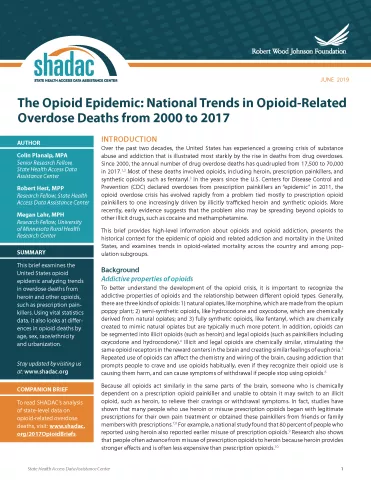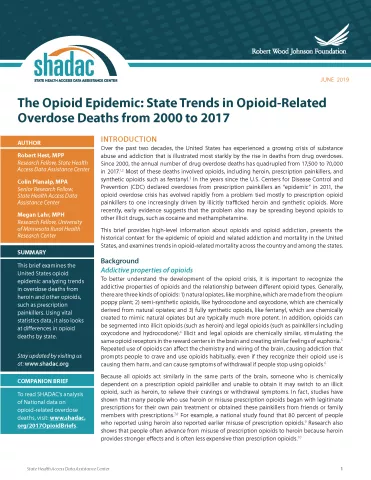Over the past two decades, the United States has experienced a growing crisis of substance abuse and addiction that is illustrated most starkly by the rise in deaths from drug overdoses. Since 2000, the annual number of drug overdose deaths has quadrupled from 17,500 to 70,000 in 2017.1,2 Most of these deaths involved opioids, including heroin, prescription painkillers, and synthetic opioids such as fentanyl.3
However, in the years since the U.S. Centers for Disease Control and Prevention (CDC) declared overdoses from prescription painkillers an “epidemic” in 2011, the opioid overdose crisis has evolved rapidly from a problem tied mostly to prescription opioid painkillers to one increasingly driven by illicitly trafficked heroin and synthetic opioids. More recently, early evidence suggests that the problem also may be spreading beyond opioids to other illicit drugs, such as cocaine and psychostimulants (e.g., methamphetamine).
These two briefs, produced by SHADAC researchers, provide high-level information about opioids and opioid addiction, present the historical context for the epidemic of opioid-related addiction and mortality in the United States, and examine trends in opioid-related mortality across the nation, across states, and among population subgroups. Additionally, due to growing concern and evidence that the opioid crisis may be expanding to other non-opioid illicit drugs, the briefs have been expanded this year to include data on drug overdose deaths from cocaine and psychostimulants, the two types of drugs that are most commonly involved in opioid overdoses.4,5
1 U.S. Centers for Disease Control and Prevention, National Center for Health Statistics. (2017). Drug Poisoning Mortality: United States, 1999-2015. Available at: https://www.cdc.gov/nchs/data-visualization/drug-poisoning-mortality
2 U.S. Centers for Disease Control and Prevention. (2019, January 4). Drug and Opioid-Involved Overdose Deaths — United States, 2013-2017. Morbidity and Mortality Weekly Report, 67(5152), 1419-1427. Available at: https://www.cdc.gov/mmwr/volumes/67/wr/mm675152e1.htm?s_cid=mm675152e1_w
3 U.S. Centers for Disease Control and Prevention. (2016, December 30). Increases in Drug and Opioid-Involved Overdose Deaths — United States, 2010-2015. Morbidity and Mortality Weekly Report, 65(50-51), 1445-1452. Available at: https://www.cdc.gov/mmwr/volumes/65/wr/mm655051e1.htm
4 Although reports of illicit drugs being tainted with synthetic opioids are relatively common, it is unclear whether deaths involving multiple drugs are typically the result of drugs being intentionally mixed by or unintentionally contaminated through traffickers’ sloppiness, or because individual drug users are concurrently abusing multiple different drugs of their own volition.
5 U.S. Centers for Disease Control and Prevention. (2018, December 12). Drugs Most Frequently Involved in Drug Overdose Deaths: United States, 2011-2016. National Vital Stastics Report, 67(9), 1-14. Available at: https://www.cdc.gov/nchs/data/nvsr/nvsr67/nvsr67_09-508.pdf


